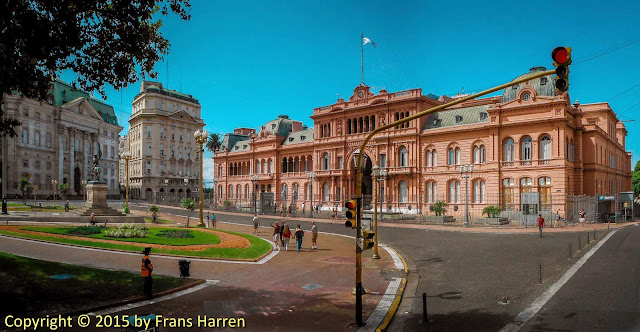
La Casa Rosada
The Pink House is the executive mansion and office of the President of Argentina. The palatial mansion is known officially as Casa de Gobierno, ("House of Government" or "Government House"). Normally, the President lives at the Quinta de Olivos, the official residence of the President of Argentina, which is located in Olivos, Buenos Aires Province. The characteristic color of the Casa Rosada is baby pink, and is considered one of the most emblematic buildings in Buenos Aires. The building also houses a museum, which contains objects relating to former presidents of Argentina. It has been declared a National Historic Monument of Argentina.
History
The Casa Rosada sits at the eastern end of the Plaza de Mayo, a large square which since the 1580 foundation of Buenos Aires has been surrounded by many of the most important political institutions of the city and of Argentina. The site, originally at the shoreline of the Río de la Plata, was first occupied by the "Fort of Juan Baltazar of Austria", a structure built on the orders of the founder of Buenos Aires, Captain Juan de Garay, in 1594. Its 1713 replacement by a masonry structure (the "Castle of San Miguel") complete with turrets made the spot the effective nerve center of colonial government. Following independence, President Bernardino Rivadavia had a Neoclassical portico built at the entrance in 1825, and the building remained unchanged until, in 1857, the fort was demolished in favor of a new customs building. Under the direction of British Argentine architect Edward Taylor, the Italianate structure functioned as Buenos Aires' largest building from 1859 until the 1890s.
The old fort's administrative annex, which survived the construction of Taylor's Customs House, was enlisted as the Presidential offices by Bartolomé Mitre in the 1860s and his successor, Domingo Sarmiento, who beautified the drab building with patios, gardens and wrought-iron grillwork, had the exterior painted pink reportedly in order to defuse political tensions by mixing the red and white colours of the country's opposing political parties: red was the color of the Federales, while white was the color of the Unitarians. An alternative explanation suggests that the original paint contained cow's blood to prevent damage from the effects of humidity. Sarmiento also authorized the construction of the Central Post Office next door in 1873, commissioning Swedish Argentine architect Carl Kihlberg, who designed this, one of the first of Buenos Aires' many examples of Second Empire architecture.
Presiding over an unprecedented socio-economic boom, President Julio Roca commissioned architect Enrique Aberg to replace the cramped State House with one resembling the neighboring Central Post Office in 1882. Following works to integrate the two structures, Roca had architect Francesco Tamburini build the iconic Italianate archway between the two in 1884. The resulting State House, still known as the "Pink House", was completed in 1898 following its eastward enlargement, works which resulted in the destruction of the customs house.
A Historical Museum was created in 1957 to display presidential memorabilia and selected belongings, such as sashes, batons, books, furniture, and three carriages. The remains of the former fort were partially excavated in 1991, and the uncovered structures were incorporated into the Museum of the Casa Rosada. Located behind the building, these works led to the rerouting of Paseo Colón Avenue, unifying the Casa Rosada with Parque Colón (Columbus Park) behind it. Plans were announced in 2009 for the restoration of surviving portions of Taylor's Customs House, as well.
See: wikipedia
Buenos Aires
Buenos Aires is the capital and largest city of Argentina, and the second-largest metropolitan area in South America, after Greater São Paulo. It is located on the western shore of the estuary of the Río de la Plata, on the continent's southeastern coast. The Greater Buenos Aires conurbation, which also includes several Buenos Aires Province districts, constitutes the third-largest conurbation in Latin America, with a population of around fifteen and a half million.
The city of Buenos Aires is neither part of Buenos Aires Province nor the Province's capital; rather, it is an autonomous district. In 1880, after decades of political infighting, Buenos Aires was federalised and removed from Buenos Aires Province. The city limits were enlarged to include the towns of Belgrano and Flores; both are now neighborhoods of the city. The 1994 constitutional amendment granted the city autonomy, hence its formal name: Ciudad Autónoma de Buenos Aires (Autonomous City of Buenos Aires). Its citizens first elected a Chief of Government (i.e. Mayor) in 1996; before, the Mayor was directly appointed by the President of the Republic.
Buenos Aires is, along with Mexico City and São Paulo, one of the three Latin American cities considered an 'alpha city' by the study GaWC5. Buenos Aires, Argentina has the third best quality of life of Latin American cities. Buenos Aires' quality of life is ranked 81st in the world, with its per capita income among the three highest in the region. It is the most visited city in South America (ahead of Rio de Janeiro) and the second most visited city across Spanish Latin America (behind Mexico City). It is also one of the most important, largest and most populous of South American capitals, often referred to as the Paris of South America.
Buenos Aires is a top tourist destination, and is known for its European-style architecture and rich cultural life, with the highest concentration of theatres in the world. Buenos Aires held the 1st Pan American Games in 1951 and the city also had two venues in the 1978 FIFA World Cup. Buenos Aires will host the 2018 Summer Youth Olympics.
People from Buenos Aires are referred to as porteños (people of the port). The city is the birthplace of pope Francis (former Archbishop of Buenos Aires), and Queen Máxima of the Netherlands.
See: wikipedia











0 comments:
Post a Comment